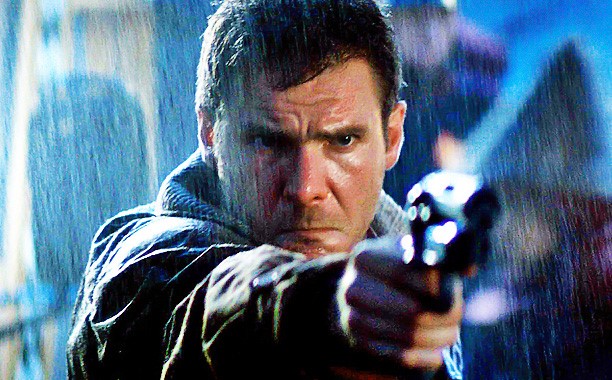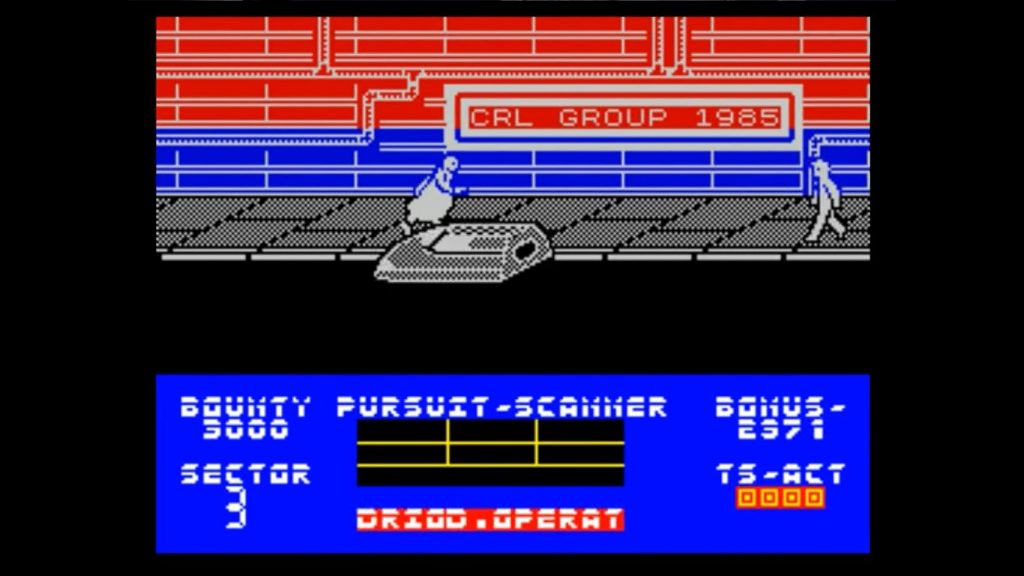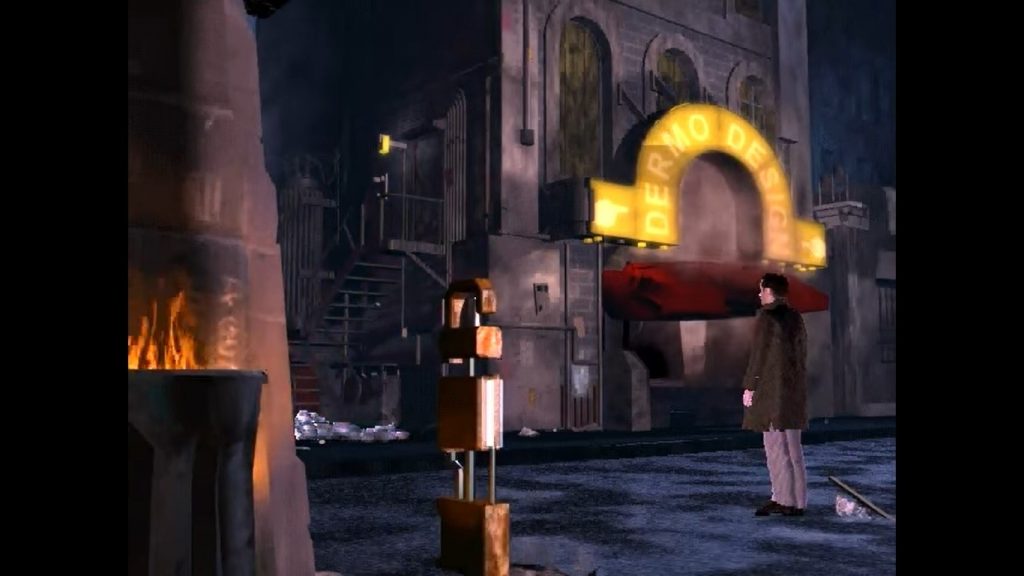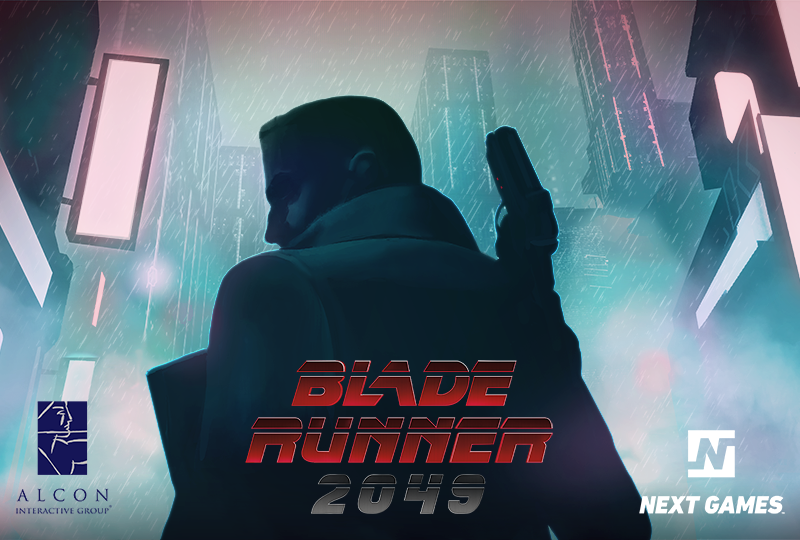
Ridley Scott’s iconic Blade Runner has inspired countless movies, books, comic books, games, and more in the decades since its release. It’s widely regarded as a masterpiece that challenged what sci-fi could be on the big screen, incorporating elements of film noir to create a unique vision of the future.
Still, considering the richness of the film’s unforgettable world and its huge following, it’s strange that only two video-game adaptations have ever been made. To celebrate the release of Blade Runner 2049, let’s look at the tie-ins we’ve already had and consider those we hope to see in years to come …
Blade Runner (1985)

In 1985, CRL Group brought Rick Deckard to the Commodore 64, ZX Spectrum, and Amstrad CPC.
However, while this game’s called Blade Runner and features recognisable elements from the film, it actually claims to be ‘an interpretation’ of Vangelis’s mesmerising soundtrack instead. Why? Because the people behind the game were unable to secure the licence, and this appears to have been a neat way to escape the complex legal complications surrounding the rights.
Despite its unofficial status, this Blade Runner tie-in captures the look and sound of the film brilliantly. The title screen is striking, while the music itself does a pretty impressive job converting Vangelis’s work, given the hardware’s immense limitations.
You’re basically tasked with running through one endless street after another, dodging pedestrians and shooting replidroids (AKA replicants). There’s not a huge amount to it, but it recreates certain touches nicely, such as Deckard’s spinner and the neon signs.
You don’t engage in fights with the replidroids: you just shoot them in the back as they try to run. In that sense, this does maybe capture more of the movie’s heart than it appears on the surface.
It wasn’t particularly well-liked at the time, to be honest, with critics drawing attention to its repetitive gameplay. Today, though, this is a fascinating artefact for fans – even if its quality comes nowhere close to the source material’s.
Blade Runner (1997)

Westwood’s Blade Runner is set during the film’s timeframe, with blade runner Ray McCoy tasked with finding criminals responsible for murdering animals while Rick Deckard hunts the escaped Nexus-6 units. As in Do Androids Dream of Electric Sheep?, ‘real’ animals are worth a fortune, while synthetic ones are widely available.
You play as McCoy, a rookie lacking Deckard’s grizzled experience, and explore some of the film’s stunning locations (Tyrell’s building, for example). Several members of the original cast return to voice their characters too, such as Sean Young, James Hong, and William Sanderson (Rachael, Chew, and J.F. Sebastian respectively).
The game does a tremendous job recreating Blade Runner’s world right from the start – the text crawl, the music, the establishing shot of 2019’s Los Angeles are all in place, while the point-and-click gameplay helps to maintain the film’s slow-burn pacing and ambient atmosphere.
You need to examine crime scenes, gather clues, and even get to use the Voight-Kampff machine to determine whether an individual’s a human or replicant. You’re armed with a pistol, like Deckard, but shooting takes a backseat (as it should).
You have a lot of freedom in how you guide McCoy through the story, and as many as 13 endings are available in the game; he’s revealed to be a replicant in some, a human in others. McCoy’s story can end on an ambiguous note too, leaving you unsure whether he’s truly human or not, much as the film does with Rick Deckard.
A genius move on Westwood’s part is the randomisation of certain elements, causing no two playthroughs to be identical. This means that of the 15 suspects you encounter, only two are always replicants, while characters’ behaviour alters from one game to another, helping to keep subsequent plays ambiguous. This is a fantastic way to design a game, and should be emulated more.
Deckard himself is referenced at times, either through dialogue or visually, while the environments are recreated to an astonishing degree (considering this game is 20 years old). While the score might not be Vangelis’s, it certainly manages to hit many of the same notes, adding to the game’s engrossing mood. The voiceover is another similarity to the film, depending on the version you prefer; it works brilliantly here, though, unlike in the movie.

Westwood’s Blade Runner can still be picked up online, but fans have been clamouring for a re-release for years now – and it’s hard to believe it hasn’t surfaced, given Blade Runner 2049’s production. This might even run well on mobile devices, if the likes of Final Fantasy VII and others of its era can.
It’s a shame a sequel was never released, but hopefully we’ll see more in the future. If we do, what might they be?
What Could Future Blade Runner Games Be?

Technology has moved on considerably since 1997, but Westwood’s Blade Runner could be given new life with a remake. The visuals up might benefit from a touch-up and the gameplay may be tweaked slightly, though the plot, randomisation, and core mechanics would be just fine as they were.
Next Games are working on a mysterious mobile game tie-in to Blade Runner 2049, and Turtle Rock Studios have VR releases covered, but what else could we hope to see?
Outside of remaking Westwood’s classic, further games could be made in the film’s world. You might play as another blade runner pursuing replicants, or perhaps as replicants on the run for your survival. Letting us play as characters as sympathetic as Roy Batty or Rachael would make for a different experience to previous Blade Runner tie-ins, and explore the film’s themes from another perspective.
The key attraction would be getting to play inside that world with cutting-edge visuals, sound, and mechanics – the crowds, the lighting, the music, and the overall grittiness could all be captured perfectly.
Even in terms of mobile gaming, touchscreen lends itself brilliantly to the point-and-click genre, so perhaps smaller titles made on a lower budget could be the way forward.
As the early positive reception to Blade Runner 2049 suggests, there’s plenty of life in the world Philip K. Dick, Ridley Scott, Hampton Fancher, David Peoples, Syd Mead, and numerous others created so long ago. Games are just one of several ways in which it could (and deserves to) be explored further.
To celebrate the release of Blade Runner 2049, we look back at previous Blade Runner games and wonder what future releases could have in store. What do you think of having more games set in the film’s world? Let us know!

